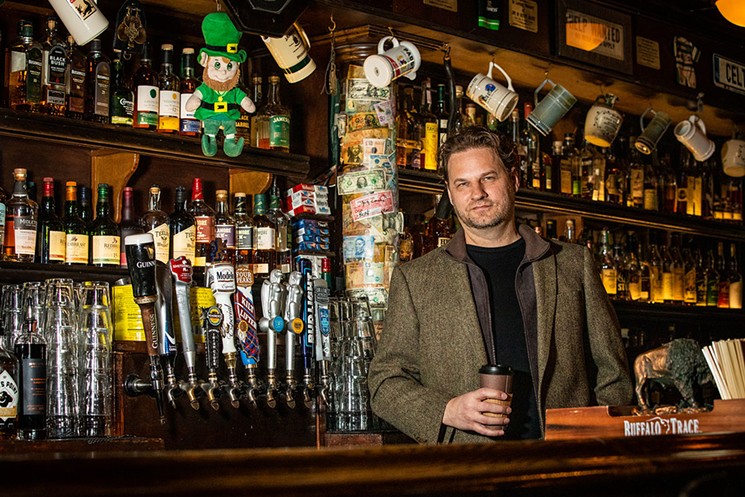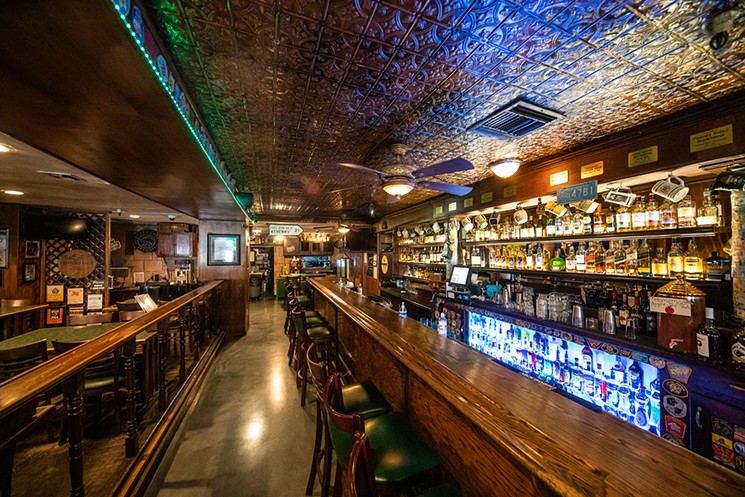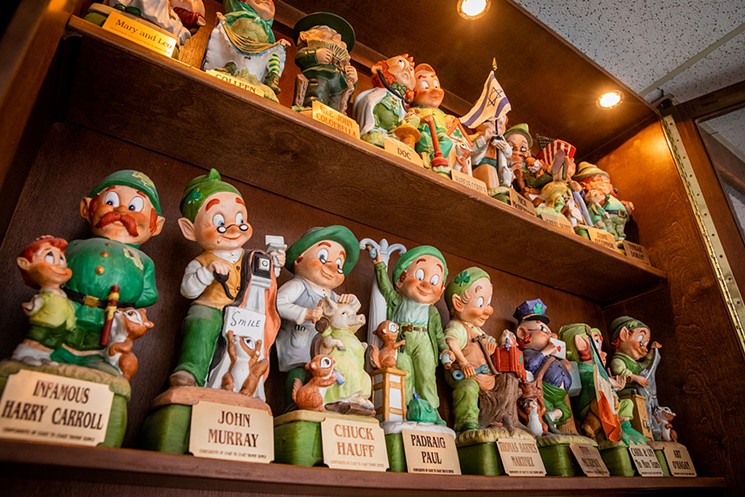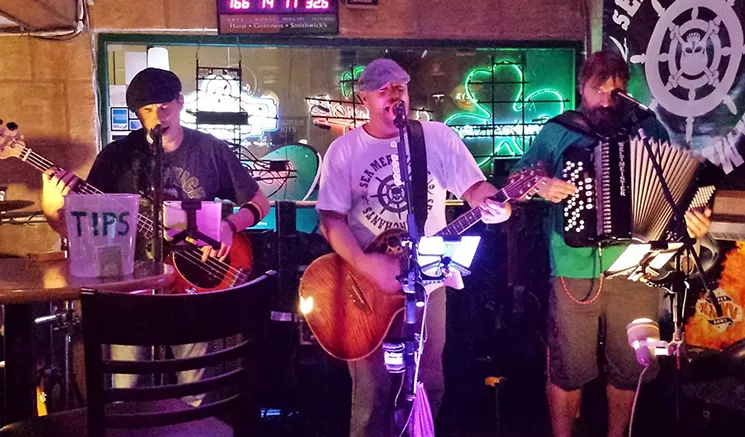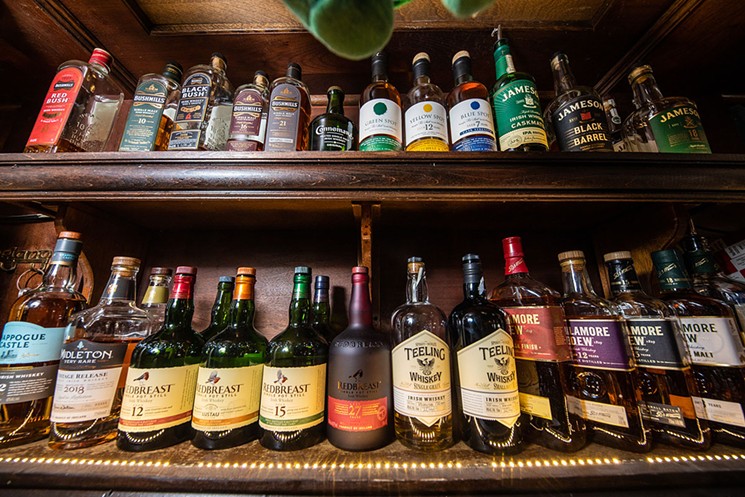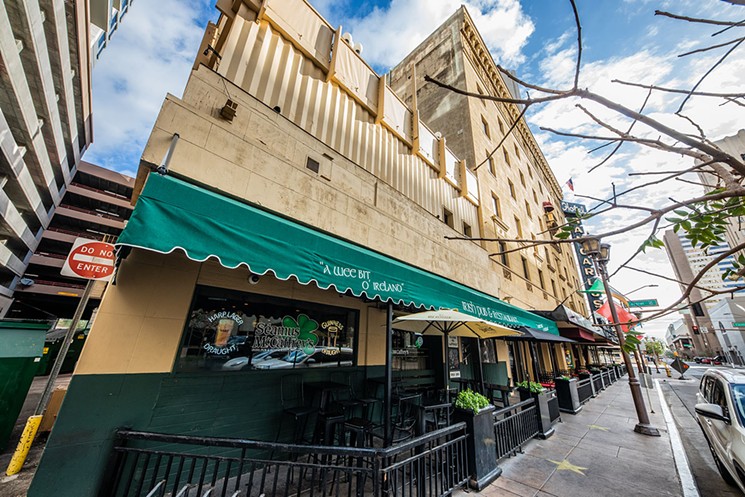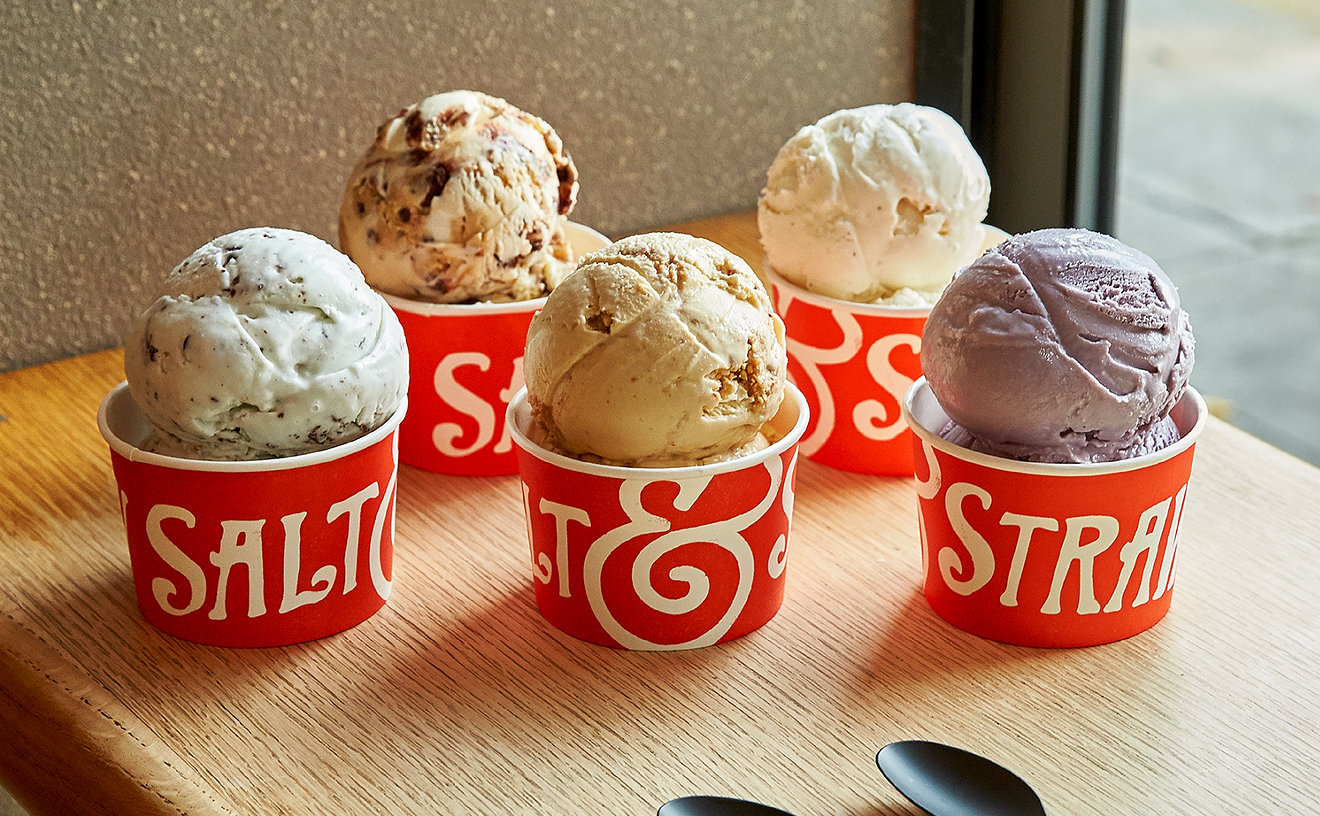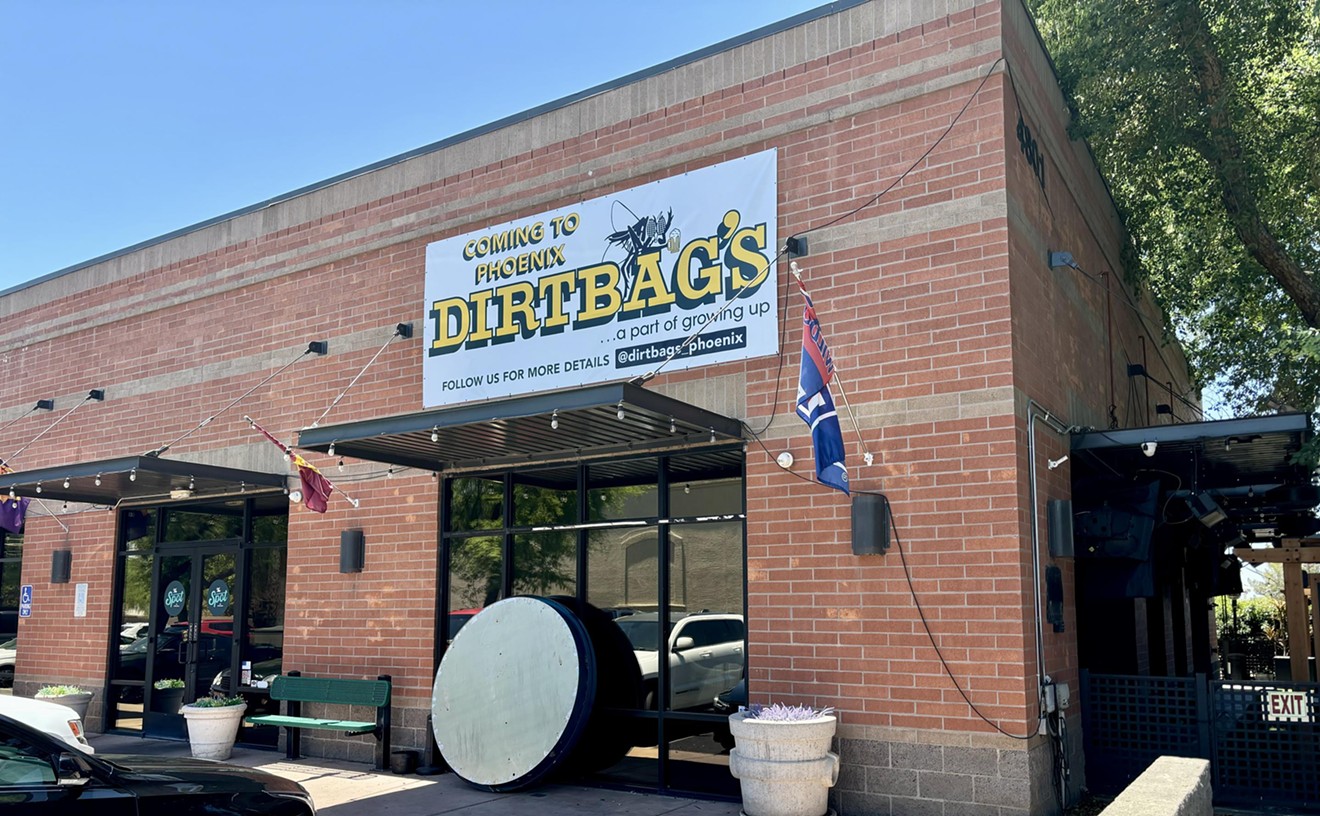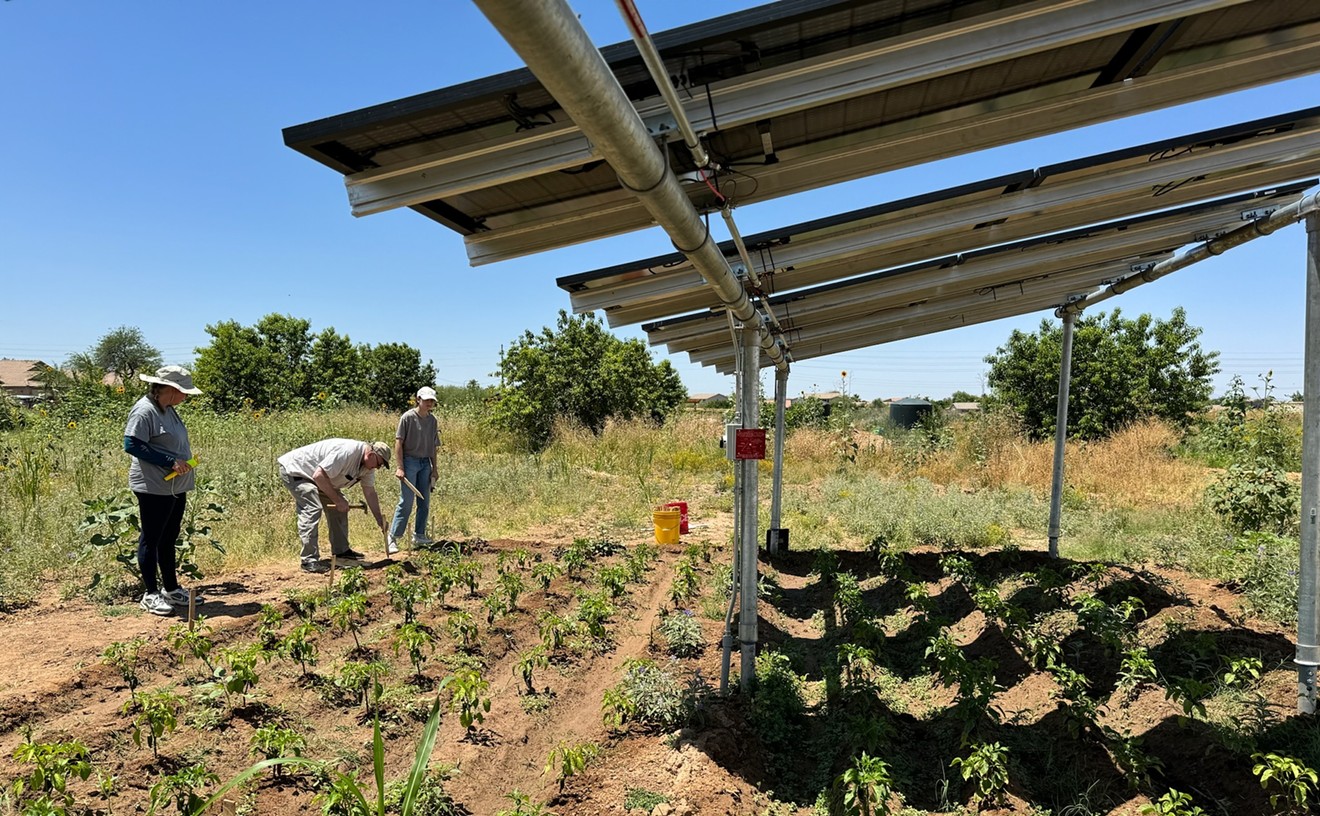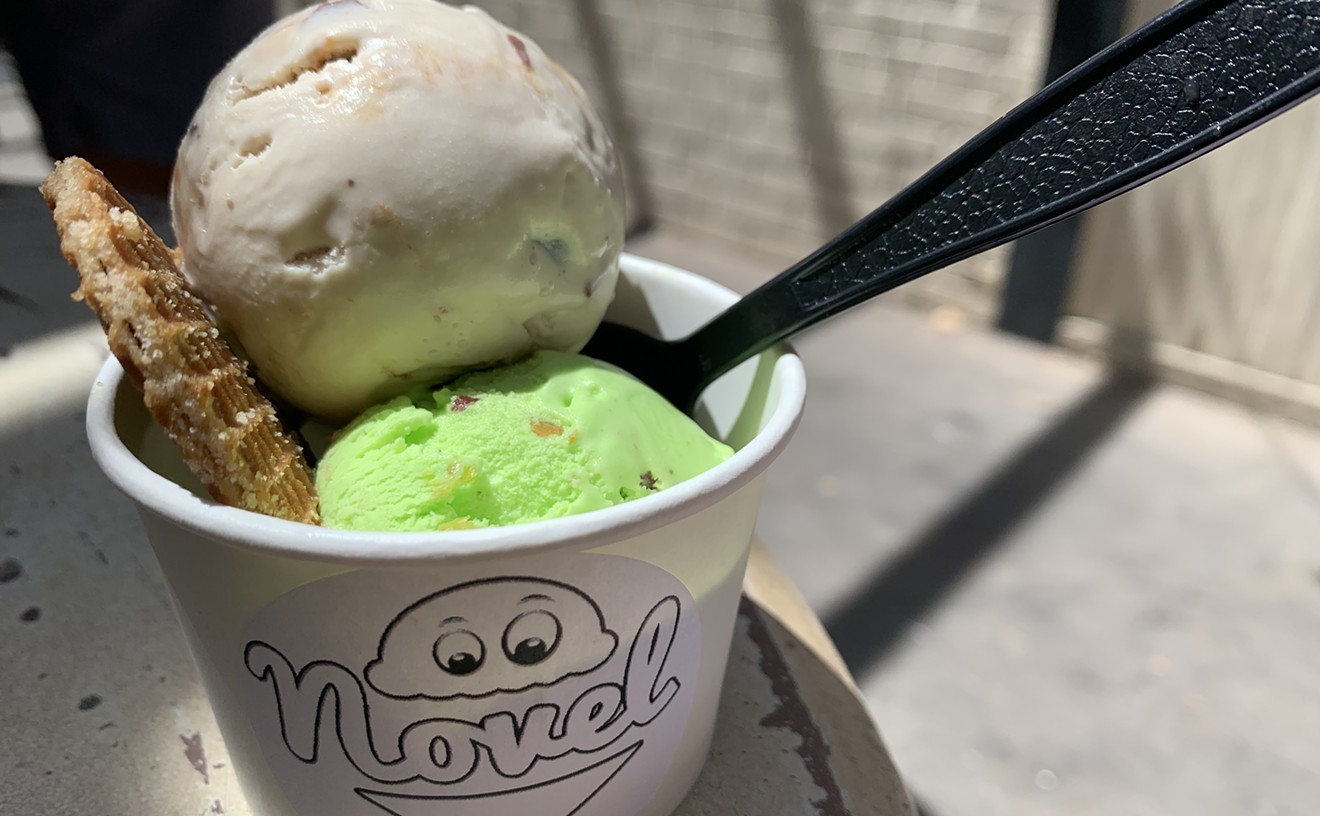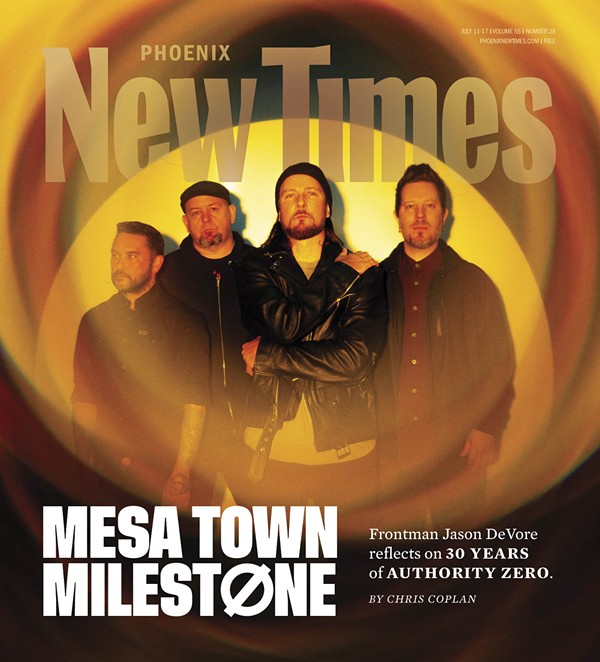Not that the downtown Phoenix pub isn't abiding by the rules. On a recent Saturday evening, seating is spaced to appropriate social distancing levels. Masks are being worn when people aren't sipping from pint glasses. There's no live band, only a Spotify playlist. Scruffy-looking doorman John "Jersey" Mazur, clad in a black hoodie and neck gaiter, is keeping things at half-capacity.
But Seamus McCaffrey's has rowdy good times built into its DNA, and in many ways, this COVID-era weekend night isn't unlike the thousands that have preceded it here on the ground floor of the Hotel San Carlos, at Monroe Street near Central Avenue. Out front, smokers swap stories at full tables. The sound of clinking glasses and laughter punctuates a thrum of Celtic punk coming from the sound system. Packs of drinkers five or six strong keep rolling up to the front door, IDs in hand. Inside, the clientele reflects the changing neighborhood that surrounds it. Upwardly mobile loft-dwellers sample the bar's vast selection of single-malt scotches. Ragamuffin artists loiter, pints in hand. Service industry workers from nearby bars belly up, having clocked out early.
It wasn't always like this. When Seamus McCaffrey, the bar's original owner and namesake, started out here 30 years ago, the Belfast-born publican was coming from north Phoenix, where in the 1980s he'd opened The Dubliner, a north Phoenix pub credited with being the first place to serve draught Guinness in the Valley. But downtown was a different animal back then. It was more skid row than stylish, nightlife was non-existent, and regular patrons were hard to find.
But McCaffrey kept the faith, stuck it out, and drinkers, Irish and otherwise, found his pub. Musicians, lawyers, politicians, business types, and city employees downtown eventually discovered the joys of a proper Irish pub. Today, Seamus is a Phoenix favorite, a go-to spot for drinkers downtown, and your favorite bartender's favorite bar.
Seamus McCaffrey's flagship festivity — its raucous annual St. Patrick's Day street party — isn't happening next week due to the pandemic. The pub will instead mark the holiday with a relatively low-key celebration. To take the sting out of that loss, we've put together this local history of the bar, full of tales from those who have bent elbows or poured pints at the pub over the years. Sláinte!
Dubliner Days
In 1981, Seamus McCaffrey came to America from the U.K., first landing on the East Coast but eventually making his way to Phoenix.Seamus McCaffrey, original owner of Seamus McCaffrey's Irish Pub: I'd met a girl, and she worked at Good Samaritan Hospital as an oncology nurse, so I came to Phoenix. The first thing I did, honestly, was look for an Irish pub, and somebody told me about one at the Biltmore called Houlihan's. I went in and asked for a pint of Guinness and the guy says, "Pint of what?" They didn't have Guinness. They didn't have Harp either. I thought, "Am I in the right place?" Basically, a light bulb went off and I thought, "If this is a big city, why don't they have an Irish pub?" So it was an invitation to open one.
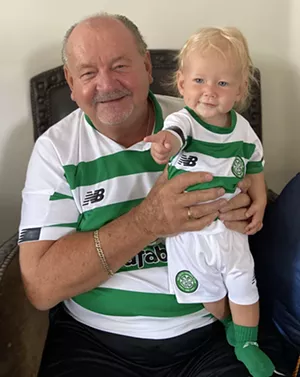
Founder and namesake Seamus McCaffrey with his grandson Brady Seamus Flick.
Kathleen McCaffrey-Flick
McCaffrey: It took me a few years to build up the money for something. I ended up selling cars at Courtesy Chevrolet for a couple of years. While I was working there, I came across a place at 40th Street and Thunderbird [Road] up for sale, and that became The Dubliner in '84, I believe.
Mirtich: It was like some dive. Seamus bought it with a partner and transformed it. You had these people who were caught off guard at first. I remember this little old lady was like, "What the hell is all this Irish nonsense?" And Seamus rolled up behind her and says, "Excuse me, ma'am. Have you ever had a pint of Guinness?" He just reeled her in. She became a regular for years.
McCaffrey: It was impossible getting Guinness on draught at first. I kept harping on the suppliers, and they'd tell me, "There's no demand for draught Guinness or draught Harp." So I hooked up with an older Irishman who worked for Guinness and he told me, "You'll be pouring it by the weekend." Of course, after that, it exploded and everybody started getting it.
Ken Mulqueen, vocalist and instrumentalist, Seanachie: He had Irish music five nights a week. There was a couple, Tom [Teven] and Marie [Kennedy], who became Celtic Pride and were mainstays. My parents and I would go down and watch them, and probably two years after that, I started learning how to play the fiddle because of that [experience]. Thirty years later, I'm still playing.
McCaffrey: People would come with their old Irish grandad or granny and tell me their stories. The Dubliner almost turned into an Irish embassy in a way.
Mirtich: My mom's Irish, so I grew up with that culture. I was bartending at a Garcia's [in the early '80s] and I started going to The Dubliner after work because they shared the same parking lot. They kind of recruited me. It was great job. All the songs reminded me of my youth, and I'd bartend at night while this older gentleman [the late Frank Murray] would bartend days. He taught me a lot.
McCaffrey: Frank was your typical old-style bartender. A New Yorker whose father was an Irish cop. He was good with the stories. A real character. One of a dying breed.
Mirtich: I was in college, because you could pay for ASU on a bartender's salary in those days, and I ended up staying a year or two after Seamus sold The Dubliner and went to downtown [Phoenix]. And Frank went with him to manage the place.
McCaffrey: I had The Dubliner for like six years, but I think I wanted another challenge. So I sold it to [the late] Jimmy O'Connor, and he had it for a few years and also started his own place, O'Connor's Pub.
Goin' Downtown
In 1991, McCaffrey's focus shifted to building a bar in downtown Phoenix. Business was slow at first. The area was largely devoid of bars, nightlife, and people after dark.Mirtich: In New York or Boston, there's a pub on every corner with that downtown feel. So he [McCaffrey] wanted to bring that sort of Irish pub he was familiar with from the East Coast to Phoenix. It made sense in his mind. Just a walk-up pub for visitors, travelers, and locals. He found a really great spot at the [Hotel] San Carlos.
McCaffrey: It was part of the hotel, the original bar from the '20s. It was closed, run down. You walked in there and everything was in shambles. It was dirty and the cockroaches almost had jockeys on them, they were that big. I leased it from [Hotel San Carlos owner] Greg Melikian, who gave us a good deal, and cleaned everything up. I built a new bar, put all my memorabilia stuff up, and added all these different little touches like these road signs I brought from Ireland.
Mirtich: At the beginning, it was something that you'd find in New York. Just a long, narrow room with a bar, a few stools, and one table in the back by the kitchen.
McCaffrey: In Ireland, some of the country bars are set up like that. So are the bathrooms. We had one little toilet for women, one little toilet for men, and you had to climb these steep stairs to get to them.
Mulqueen: The stairs weren't really as scary as the bathrooms, though, which are kind of convoluted. You've got the sink up your ass when you're at the urinal, and it's just weird.
McCaffrey: That was before baseball and basketball and everything else was down there. [It was] just an area for business [people] or undesirable people. But I thought things with it were eventually going to start turning around.
Mirtich: It was tough going. Downtown was still cleaning itself up. There was still a bit of a skid row theme in that area around Monroe and Van Buren. So a lot of people didn't think he was going to make it. There wasn't nearly the amount of corporate headquarters and offices down there yet. A few dive bars like Newman's [Lounge] and places like Tom's Tavern were around, but it wasn't a drinker's paradise. Back then, he was running sandwiches and scraping to get by.
McCaffrey: We had traditional fare at the beginning. Shepherd's pie, corned beef cabbage, Irish stew from my granny's recipe, and, of course, fish and chips. Plus, the more American burgers and sandwiches. A lot of lunch crowds kept us going at first. Nightlife was pretty slow starting off, because downtown at that time closed up real early. A couple of lawyers were friends of mine. They really helped out by having Friday happy hours, office parties, and stuff like that at the pub.
Patrick Paul, attorney and longtime patron: I was in my early days at Gallagher & Kennedy in 1992. A group of us were folks in our early to mid-twenties and someone would select a location to go for happy hour each Friday evening. When my number came up, I picked up this thing called the Yellow Pages and went to "Restaurant, Bars" and under "Irish," there was only one listed: Seamus McCaffrey's. Nobody had heard of it, but everybody had to abide by my choice. We went down there and it became a favorite.
Mirtich: As things went on, a lot of the attorneys and government people downtown began to discover the pub.
Paul: I think that's not an unfair statement to say Seamus' became a lawyer hangout. It was more of a social and cultural experience than maybe Durant's might've been for the let's-get-a-deal-done crowd. More relaxed and shirt-and-tie-not-required, if you will. I happen to be a lawyer, but my tether is a little bit different. I'm first-generation [Irish], so it was more important to me to find a place where the culture could be celebrated.
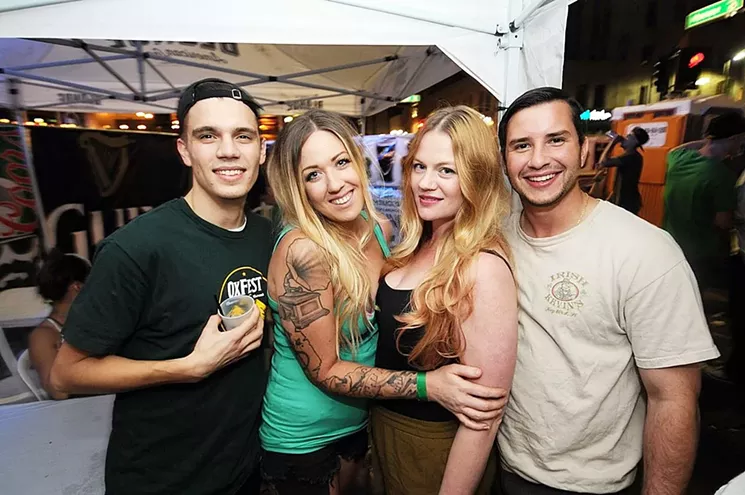
Seamus McCaffrey's yearly St. Patrick's Day street party is pretty packed with drinkers, green, and drinkers wearing green.
Benjamin Leatherman
Mirtich: We had great attendance back in the '90s, and it's really stayed traditionally the same ever since: step-dancers, bagpipers, and Irish bands all day. We shut down Monroe and put up a big tent. The only thing that's changed is just how much it's grown and the fact that now we go all the way to Central.
Colleen Collins, vocalist and instrumentalist, Kilted Spirit: It's always packed. It's just wall-to-wall people. A lot of people dancing around. And green everywhere, green and beer.
Mirtich: It's been a charity event from the start. Seamus worked with the Muscular Dystrophy Association at the beginning. Nowadays, it benefits the United Phoenix Fire Fighters Emerald Society.
Seamus McCaffrey’s had other ways of raising funds for charity in its early years, like having patrons sponsor a series of quaint leprechaun figurines on display at the pub.
McCaffrey: A friend of mine had all these leprechauns and he wanted $25 each. They're all music boxes and liquor [decanters] and they're worth a lot more today. I bought them all, thinking it'd be nice for the pub. I put plaques with the names of people who’d donate $25 to the Muscular Dystrophy Association each year.
Paul: In the early days, there was probably a half-dozen to 10 of those. That expanded, I'd say there’s maybe 20 now. I was among the earlier contributors and it's still there. I like to go back and see it once in a while.
On a Roll
By the mid-'90s, Seamus McCaffrey's was a fixture of downtown and one of the cornerstones of the local Irish music scene, known for its raucous gigs and premier selection of Scotch and Irish whiskeys. The occasional famous face graced the pub, as did soccer fans who came for watch parties.McCaffrey: We started having music early on. Just bringing in different local bands and having them play up by the front.
Mulqueen: It was this small area on the landing by the windows and they'd move a few tables out of the way each night. I think it barely qualifies as a stage. Trying to put five guys on a stage in there was a little tight. For the fiddle, I could angle my way around. But the guitar players and bass player, they had to keep their instruments from banging off each other. You made it work somehow. And when the bands were playing, it was people from the Irish community that started to show up.
McCaffrey: On a Friday night, if you weren't there by 6:30, you weren't getting in. It was packed. We'd knocked one wall down by those days for more [seating], but it would still be packed.
Mulqueen: You'd have people in all the tables and the bar would just be three-four deep. It was a pain if you had to go to the bathroom, trying to get past people. But you probably knew everyone there, so you'd stop and catch up and it'd take a half an hour to get to the bathroom and back.
Tim Whalen, vocalist and instrumentalist, Spirited Lads: The thing I've loved about it when you step in there, you're transported to some place very unlike Phoenix. Feels like a pub anywhere in Ireland. It's got the ambiance and the people. The craic, as the Irish say, was always happening there. I mean, it's called a "pub" because the old public houses in Ireland is where people would gather in the evenings, play music, and tell stories. And Seamus' has always had that vibe.
Patrick Flanagan, guitarist, Saints of Éirinn and Keltic Cowboys: We drove the whiskey sales there whenever we played, it was all about pushing the booze and the tunes.
Shay Veno, vocalist and guitarist, The Clare Voyants: People came out in droves and took up all the tables. You'd try to reorganize things to get [your fans] to be front and center and loud and raucous, clinking glasses and pounding tables, in order for the sound to reach the back. I felt at home there and generally the servers there were all great. Frank was brilliant in terms of dealing with people and conflicts and Andy came to work there, too. He was an astute tutelage under Frank.
Mirtich: I graduated from ASU and was in the business world for a couple years, but I didn't jibe with sitting in an office. Seamus goes, "Why don't you come down here? We need someone to manage during the day." Working with Seamus and Frank again was a better option.
Paul: They all had such a good relationship. Frank was almost like Seamus' uncle, and Andy was the equivalent of their nephew or son.
Mirtich: Through the '90s and into the 2000s, hands down, we had the largest single-malt scotch collection in the state. Seamus always had a nice selection of Irish whiskeys: Midleton, Jameson, Bushmills, Redbreast. I definitely got more into the Scotches working here. The Glenmorangie distillery released the Port Wood Finish, the Madeira Wood Finish, and all these variations, and I was ordering back then. I'd say, "Just give me one of everything."
Kathleen Mccaffrey-Flick, Seamus McCaffrey's daughter and manager of Rosie McCaffrey's Irish Pub: My dad's a big soccer fan and his team has always been Glasgow Celtic out of Scotland. All the pubs he's had, he's [hosted] the supporters club. When I was little, I'd go down to Seamus' with him to watch the games there. But with the time difference, they could be anywhere from 4 to 7 in the morning. I remember sleeping in the booths with the chairs pushed together while he was watching soccer.
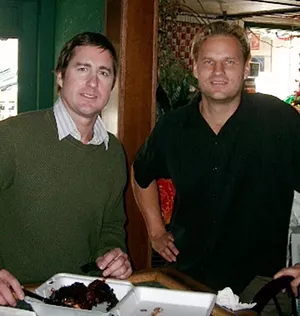
Actor Luke Wilson (left) with Andrew Mirtich during the filming of Middle Men in 2009.
Courtesy of Andrew Mirtich
Paul: One of Frank Sinatra's last performances was at America West Arena. It wasn't a very good show as poor Frank was on his last legs. But his son, Frank Jr., was the orchestra director at the time. After the show, several of us went to Seamus McCaffrey's, and guess who else showed up? Frank Sinatra Jr. He struck up and played for an hour or so. Just totally gratis, a private concert for 20 or 30.
Mirtich: I served Henry Thomas from E.T. beers once. And Kim Basinger came in when they were filming a remake of The Getaway [in downtown].
Mirtich: We've done little dating shows here and there. They rented out Seamus' from me for this movie Leather and Iron and actually drove a Harley through the bar and out the front door. Middle Men [a 2009 techno-drama] was probably the coolest shoot because it was a major feature film and Luke Wilson was there with John Ashton, James Caan, and Robert Forster. They were giving me $5,000, and I said, "I also want a front-row seat for me and a couple friends and I'll shut down for the day." And I just sat at the bar with my buddies and drank whiskey and watched the filming.
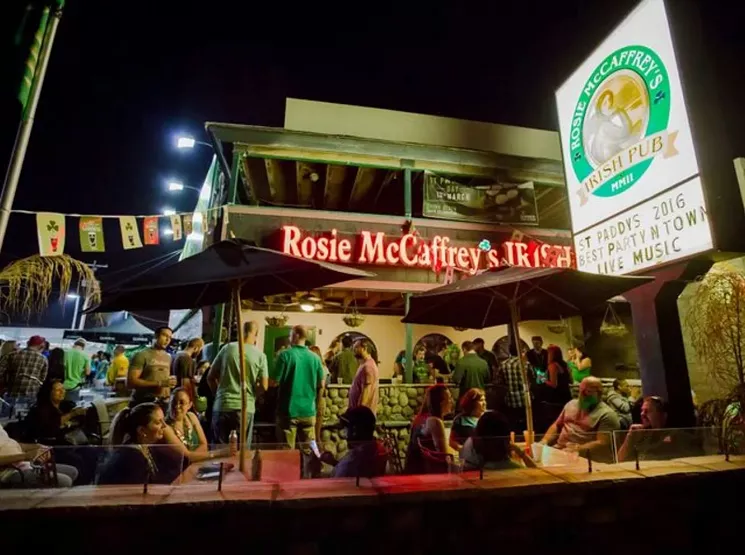
Rosie McCaffrey's Irish Pub on Camelback Road, which Seamus McCaffrey opened in 2002.
Rosie McCaffrey's Facebook
Irish Exits
In 2001, McCaffrey sold his namesake pub to Murray and Mirtich after deciding to open a new spot at Ninth Street and Camelback Road. He named it Rosie McCaffrey's after his wife.McCaffrey: It was just another challenge. When I first came to Phoenix, there was a wee place on Camelback. I remember going there and saying, "God this would make a great Irish pub." In 2001, I was driving by and saw a "for sale" sign. I called the fella up and we got together and got a deal going. It was fate.
McCaffrey-Flick: It used to be called The Good Egg and had gone on the market. He [Seamus] had his eye on it for 20 years and was lucky enough to be in the right place at the right time.
McCaffrey: We gutted the place to its four walls, built a new bar, brought in more memorabilia, and it became my Rosie's.
Mirtich: He's just a real loyal guy. Could he have gotten more money for it back in '01? Maybe. But he came straight to us first and said, "I'm selling and giving you guys first crack at it."
Paul: Frank and Andy jointly bought the place, worked together, and put their own touches on it, including expanding [to a third room]. The menu largely stayed the same. The traditions stayed the same.
In the early 2010s, downtown Phoenix saw an influx of new bars and more foot traffic as it went through a resurgence as a nightlife hub.
Joe Dooda, former doorman: The only thing that's truly different about Seamus is the patrons. As downtown has changed, so have the people.
Mike Fisher, current Seamus McCaffrey's bartender: When Crescent [Ballroom] and other bars started nearby, it helped out a lot because it created more people. Everybody's afraid about another bar opening up, but it's not the case. It just brings more people to the area.
Flanagan: People like to do the bar crawl kind of thing, going from place to place. So the crowd will constantly change all night long. You could go every half hour or so, it would be a completely different cast of characters, kind of like watching a parade go by at times. The Young Dubliners were playing around the corner once at the Crescent Ballroom and showed up to check out our set. We didn't even realize that they were there until we'd finished our last song. Keith commented on "Lanigan's Ball," and said he loved the version that we did.
Dave Foley, vocalist and guitarist, The Sea Merchants: Certain nights, like First Fridays, were always big. It would get pretty packed with artists.
Fisher: We used to get wrestlers in after WWE events at the [Phoenix Suns Arena]. The Miz was here 'til last call, like nine or 10 years ago. He was just like he was on The Real World. Sheamus has been in here, too. He was very calm, very polite.
Erick Biez, local bartender and comedian: I started hanging out at Seamus' in 2010. One of my first jobs after moving here was at the Arizona Center. I asked my co-workers, "Where do people hang out around here?" They told me to go to Seamus. A lot of [service industry workers] downtown will meet up there right after work. They'd even let us call in our orders ahead of time so we could make it in time for last call. We could still catch beers in case we were stuck doing our own last call.
In April 2011, Frank Murray suffered a heart attack and died four months later at the age of 78. Mirtich became the sole owner.
Mirtech: We had a great friendship and our partnership was successful, I think, because I humbled myself and said, "Look, I'm going to let this gentleman who's worked a lot more years than me take the reins and defer to his better judgment. I'll have my chance down the road."
McCaffrey: Frank was almost like a father figure to me. He kept me straight. On nights when I'd had one too many, he had that way of saying things where he looked at me and went, "Seamus, it's time to go." "Okay, Frank." He was always looking over my shoulder.
Veno: Frank was sort of the archetype of what any bartender should aspire to be. He was brilliant at deescalating a situation that was on the cusp of going out of control.
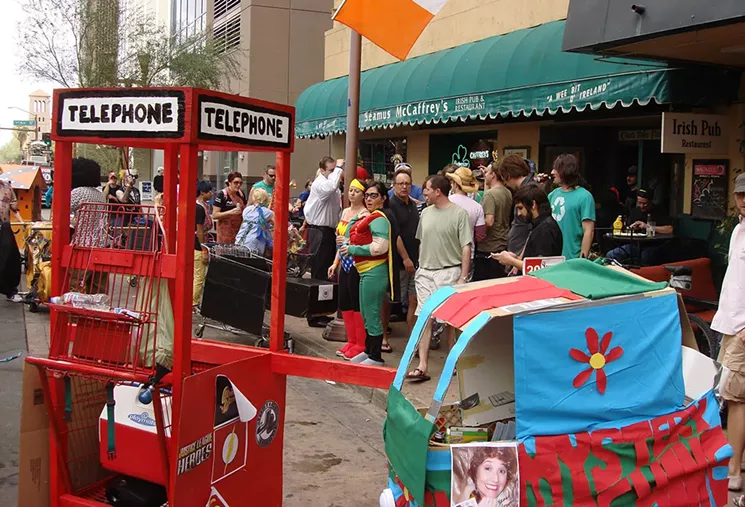
Chaos outside of Seamus McCaffrey's during the Phoenix Idiotarod in 2009.
Courtesy of Andrew Mirtich
Biez: I was at the pub in 2013 when a guy who got kicked out came back with two steak knives. Instead of the bouncers getting involved, the patrons scared the guy off. My buddy held a chair out like a lion tamer and tried swinging it at the guy so he wouldn't stab the bouncer. And the guy threw the last knife that he had and everybody dropped their stuff and took off from the patio and chased him all the way down to the YMCA nearby.
Jaime Woods, former Seamus McCaffrey's bartender: In all of my time working here, and I don't want to jinx anybody, but nobody's ever been hurt on the [bathroom] stairwell. And there have been so many drunken nights, and people have done dumb stuff here, but nobody's been seriously hurt going up and down those steep, creaky stairs.
Dooda: There's gotta be a guardian angel watching over that part of the bar.
Biez: Really crazy things only seem to happen on slow nights. I literally walked in once to see Sebastian Bach just hanging out on a random evening. At first I was like, "Weird...why is there so much Skid Row playing?" And someone said, "Sebastian Bach is here." I asked the bartender at the time and he was like, "We [booted up] the jukebox and he's just been singing his own songs by himself." I ended up sitting next to him watching the lead singer of Skid Row sing his own songs drunkenly. I thought, "This is bizarre."
Dooda: They got rid of the jukebox a few years ago because people were playing bad music. They'd ride by on their bicycles and play, like, Russian disco [remotely] through TouchTunes when they weren't even here, to be a dick. They got rid of it about a year ago and we now play all our music through Spotify because we can't trust anybody.
Along with every other Irish bar in the Valley, Seamus McCaffrey's was walloped by the first wave of shutdowns as the pandemic hit Arizona last March. Less than 48 hours before St. Patrick's Day, Arizona Governor Doug Ducey strongly urged public events with more than 50 people to cancel. Some bars went forward with their parties; Mirtich erred on the side of caution.
Mirtich: It was a nightmare. It couldn't have been worse timing because we shut down the night before St. Patrick's Day, and I know they were trying to prevent a superspreader event. I won't tell you the exact amount of how much we lost, other than to say it was a lot. It was a gut punch, not just for me, but also the Phoenix Emerald Society, the charity we support. They lost, we lost, the community lost. And it's going to hurt times two, because we're not holding a street party for the second year in a row. I just don't think we're near the point where it'd be acceptable.
Collins: It's really a shame since it's such a joyous event that we always look forward to playing, though I understand why it's not happening again this year.
Mirtich: COVID is obviously the biggest test we've faced, with the [Great Recession] probably being the second, and when the DUI laws toughened [in the early 2000s], we definitely saw a lot of downturn. We've always found a way to survive. It's a little unsettling what's happened to daytime business. It's been decimated. It's almost like going back to the '90s. There's no one around with a slow trickle of people coming back to work and a few people coming in for lunch. It's certainly strange after 30 years to build up and see just that steady rocking business go back to square one. But I believe that an Irish pub should stay open, which goes back to the roots of a public house in Ireland. If the government tells us to close, we'll close. But as long as I can legally be open, we're going to plant a bartender there and a cook and open our doors.
Editor's note: Some quotes were edited or condensed for clarity.


